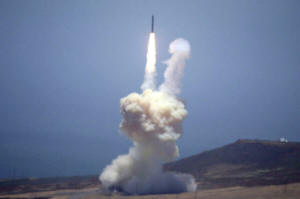|
Pentagon successfully tests ICBM defense
system for first time
 Send a link to a friend
Send a link to a friend
 [May 31, 2017]
By Phil Stewart and Lucy Nicholson [May 31, 2017]
By Phil Stewart and Lucy Nicholson
WASHINGTON/
VANDENBERG AIR FORCE BASE,
Calif. (Reuters) - The U.S. military on Tuesday cheered a successful,
first-ever missile defense test involving a simulated attack by an
intercontinental ballistic missile, in a major milestone for a program
meant to defend against a mounting North Korean threat.
The U.S. military fired an ICBM-type missile from the Kwajalein Atoll in
the Marshall Islands toward the waters just south of Alaska. It then
fired a missile to intercept it from Vandenberg Air Force Base in
California.
Experts compare the job to hitting a bullet with another bullet and note
the complexity is magnified by the enormous distances involved.
The Missile Defense Agency said it was the first live-fire test against
a simulated ICBM for the Ground-based Midcourse Defense (GMD), managed
by Boeing Co <BA.N>, and hailed it as an "incredible accomplishment."
"This system is vitally important to the defense of our homeland, and
this test demonstrates that we have a capable, credible deterrent
against a very real threat," Vice Admiral Jim Syring, director of the
agency, said in a statement.

A successful test was by no means guaranteed and the Pentagon sought to
manage expectations earlier in the day, noting that the United States
had multiple ways to try to shoot down a missile from North Korea.
"This is one element of a broader missile defense strategy that we can
use to employ against potential threats," Pentagon spokesman Captain
Jeff Davis told reporters.
Prior to Tuesday's launch, the GMD system had successfully hit its
target in only nine of 17 tests since 1999. The last test was in 2014.
North Korea has dramatically ramped up missile tests over the past year
in its effort to develop an ICBM that can strike the U.S. mainland.
The continental United States is around 9,000 km (5,500 miles) from
North Korea. ICBMs have a minimum range of about 5,500 km (3,400 miles),
but some are designed to travel 10,000 km (6,200 miles) or farther.
[to top of second column] |

The Ground-based Midcourse Defense (GMD) element of the U.S.
ballistic missile defense system launches during a flight test from
Vandenberg Air Force Base, California, U.S., May 30, 2017.
REUTERS/Lucy Nicholson

Riki Ellison, founder of the Missile Defense Advocacy Alliance,
described the test as "vital" prior to launch.
"We are replicating our ability to defend the United States of
America from North Korea, today," Ellison said.
Failure could have deepened concern about a program that according
to one estimate has so far cost more than $40 billion. Its success
could translate into calls by Congress to speed development.
In the fiscal year 2018 budget proposal sent to Congress last week,
the Pentagon requested $7.9 billion for the Missile Defense Agency,
including about $1.5 billion for the GMD program.
A 2016 assessment released by the Pentagon's weapons testing office
in January said that U.S. ground-based interceptors meant to knock
out any incoming ICBM still had low reliability, giving the system a
limited capability of shielding the United States.
(Additional reporting by Idrees Ali in Washington; Editing by Steve
Orlofsky and James Dalgleish)
[© 2017 Thomson Reuters. All rights
reserved.]
Copyright 2017 Reuters. All rights reserved. This material may not be published,
broadcast, rewritten or redistributed.

 |